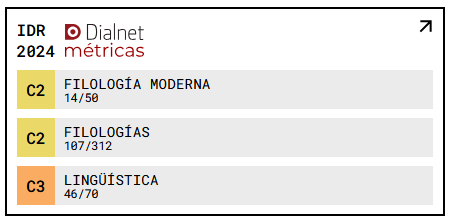Defining in English : a tool to measure writings abilities
DOI:
https://doi.org/10.18172/jes.66Abstract
Drawing conclusions, comparing and contrasting, defining, explaining reasons and purposes, speculating and verifying, inferring and implying and other patterns of writing organisation, are the very matter of communication, whether in the form of everyday conversation or more highly specialised uses of language. These functions of language could be used to measure foreign language students' capability in different skills, writing for instance. This paper deals with the ability to write definitions, as an alternative to essay writing, of the students of English Language in the 1st year of English Philology at the University of Murcia. They were asked to define 10 words accurately chosen from the vocabulary lists published by Nation (1999). The results obtained have been used as a parameter to measure their writing ability. Significant correlations have been found between the marks obtained in the Oxford Placement Test performed at the beginning of the semester and those in our test based on definitions. We propose that definitions be considered as a parameter to check the writing abilities of the students and as a complement to the Oxford Placement TestDownloads
References
Alcaraz Varó, E. 2000. El inglés profesional y académico. Madrid: Alianza Editorial.
Cambridge International Dictionary of English. 1996. Cambridge: CUP.
Collins English Dictionary. 1995. Harper Collins Publisher CD-ROM.
Downie, N. M. & Heath, R. W. 1971. Métodos estadísticos aplicados. Madrid: Ediciones del Castillo. Translation from Basic Statistical Methods (1970). New York: Harper & Row. 100-116, 247-256, 336.
Hamp-Lyons, L. and Heasley, B. 1987. Study Writing. Cambridge: CUP.
Ilson. R. 1991. “Lexicography”. The Linguistics Dictionary. Ed. K.
Malmkjaer. London: Routledge.
Jordan, R. R. 1996. Academic Writing Course. Harlow: Longman.
Jordan, R. R. 1997. English for Academic Purposes. Cambridge: CUP.
Morenberg, M. 2002. Doing Grammar. 3rd edition. Oxford: OUP.
Nation, P. http://www.vuw.ac.nz/lals/staff/paul_nation/index.html.
Partington, A. 1996. Using Corpora for English Language Research and Teaching. Amsterdam: John Benjamins Publishing Company.
Rudska, B., J. Channell, P. Ostyn and T. Purseys, 1985. More Words You Need. London: Macmillan Rudska, B., J. Channell, P. Ostyn and T. Putseys. 1982. The Words You Need. London: Macmillan.
Skehan, P. 1989 Individual differences in Second Language Learning. London: Edward Arnold.
Wilkins, D. A. 1986. Notional Syllabuses. Oxford: Oxford University Press.
Woods, A., Fletcher, P. & Hughes, A. (1986). Statistics in Language Studies. Cambridge: Cambridge University Press.
Downloads
Published
How to Cite
Issue
Section
License
The authors retain copyright of articles and authorize Journal of English Studies the first publication. They are free to share, redistribute, and/or reprint the article without obtaining permission from the publisher as long as they give appropriate credit to the editor and the journal.
Self-archiving is allowed too. In fact, it is recommendable to deposit a PDF version of the paper in academic and/or institutional repositories.
It is recommended to include the DOI number.
This journal is licensed under a Creative Commons Attribution 4.0 International License














